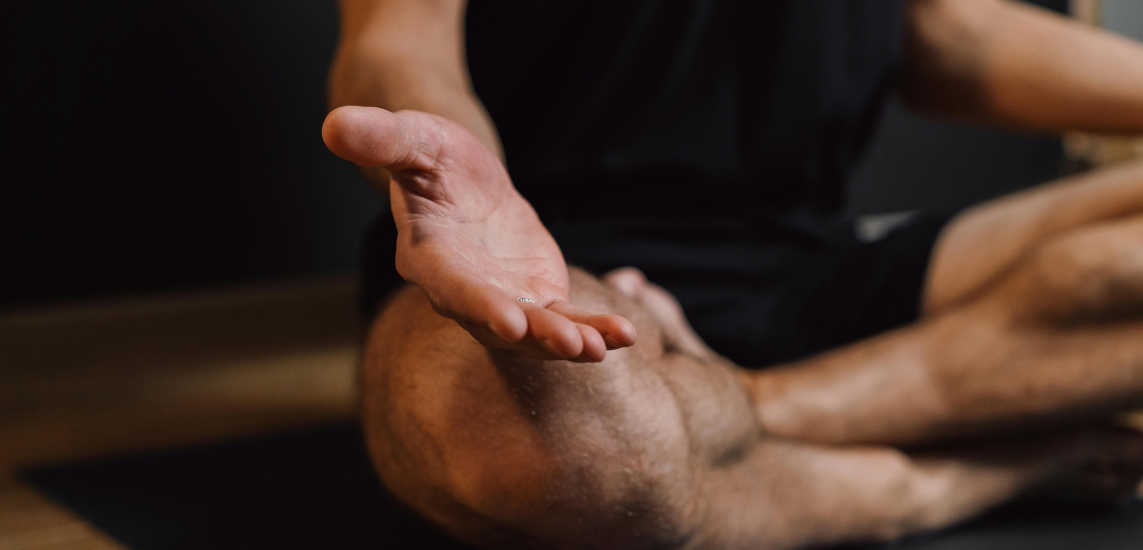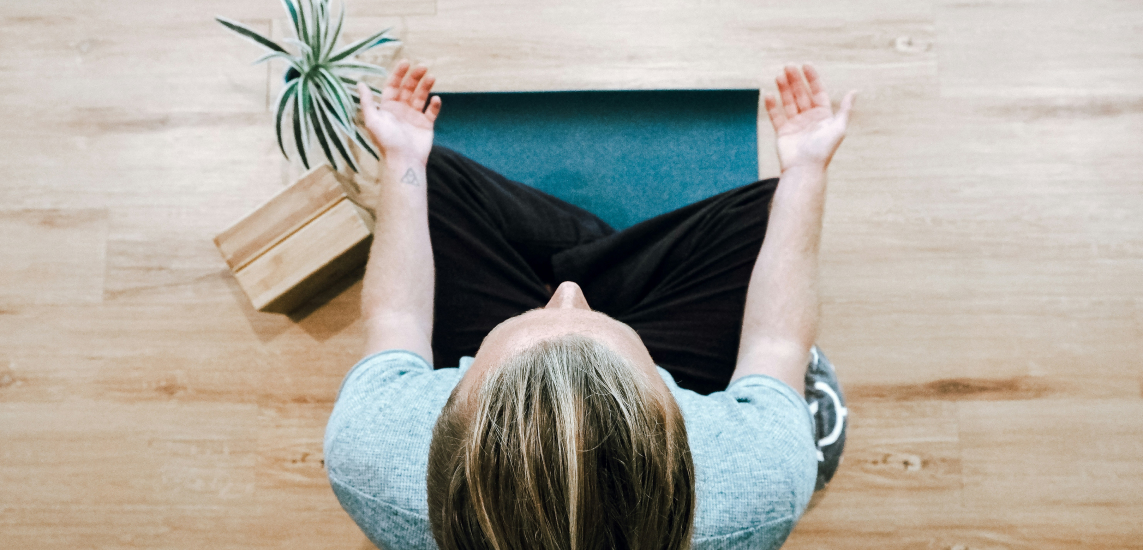In this article, Dr. Irene Cop shares supportive guidance and meditation techniques for beginners.
Meditation Techniques For Beginners: The First Steps
The Cambridge dictionary defines meditation as the act of giving your attention to only one thing, either as a religious activity or as a way of becoming calm and relaxed. Having taught neurophysiological meditation for over twenty-five years, I admit I have a very practical wellness-based approach to meditation. If it helps you relax and feel better, you’re meditating… and no, I’m not talking about using external helpers!
In all seriousness, meditation:
- doesn’t need to be done just sitting.
- doesn’t need to be performed for hours on end.
- doesn’t need to be hard.
Meditation is about focusing positively on the here and now, rather than dwelling on past failures or future worries, and can be done anytime, anywhere… in just seconds or minutes. It can even be fun! Meditation can also be about expanding your consciousness and your relationship with the Universe.
And you need to start somewhere. You’re not ready to graduate from college as soon as you start kindergarten. If you’re ready to learn 15 fast easy, proven meditation techniques for beginners and experienced practitioners to calm your monkey mind chatter and develop the habit of lifelong meditation, read on.
Inch By Inch, Everything’s A Crinch
A word of caution… Your new intention will be sabotaged by your unconscious mind because it fears change.
To fly under your unconscious mind’s radar and minimize the possibility of being derailed from your meditation aspirations, Rod Hairston recommends the following guides:
Make it as easy and convenient as possible to meditate.
Since that’s the whole point of this article, we’ve got you covered on this one!
Make it as enjoyable as possible.
You are more likely to continue an activity you find enjoyable. Choose meditation activities and techniques that feel good to you, rather than swimming upstream in the hopes you’ll come to like it.
For quiet meditations, choose a place that is peaceful and soothing… your safe place where you won’t be disturbed.
Buddy up with someone to hold you accountable. The free meditation app Insight Timer allows you to connect with friends so that you can see each other’s activities. There are also over 7000 groups on Insight Timer to allow you to connect with like-minded people.
Start with baby steps to the point of feeling like you’re doing almost nothing.
This is the most important of all! If you start out by meditating even 15 or 30 minutes, the alarms are going to clang in your unconscious mind. The higher the alert triggered, the greater the potential self-sabotage — setting yourself up for failure. Before you know it, you’ll have likely fallen off the meditation wagon.
This is why I have included exercises which take less than a minute to do. And all of the following exercises take less than 5 minutes so that your alarm bells stay as quiet as possible. Choose one exercise each day and do only that one, even if you have the time and inclination to do more. When you’ve worked through these exercises, Insight Timer allows you to choose meditations based on time. Choose ones from the 5 minutes section for two weeks, then 10 minutes and so on. Before you know it, the habit of meditating will be ingrained in you.
Read more: Explore ten one-minute meditation practices to begin or enhance the ritual.
Once you’re well on the way, you can then start expanding the duration of your meditation practice more and more without resistance from your unconscious mind.
An added benefit is that you will soon be feeling better about yourself — physically, emotionally and mentally — so that you’ll be ready to step up to the next level of meditation and expand your consciousness if you so choose.
15 Meditation Techniques For Beginners: Awareness, Breath & Visualization
Awareness: Actions Create Feelings
The first step in any change is awareness of your old habits and patterns which no longer serve you. As Dr. Joe Dispenza states, your habits and behaviours dictate what your thoughts and emotions will be.
Actions really do speak louder than words… especially to your unconscious mind which is running the stress show. If your posture is relaxed, you are relaxed. If your muscles are relaxed, then you are relaxed. Most of the time you’re probably not even aware of your posture. If you are, you haven’t realized that you have the power to change it and change your emotions.
Let’s work through some awareness exercises to show you the power of your physiology on impacting your emotions:
1. Posture: Try different postures to see how they make you feel
Exercise:
- Shoulders shrugged up and hunched over, fists clenched, glower on your face
- Standing straight and tall, shoulders down, chin up, smiling, hands relaxed
2. Smile!
Exercise:
If you’re feeling down, smile. Place a pencil between your teeth if need be. Aside from laughing at yourself, forcing your mouth into a smile even if you’re not in the mood will actually lift your spirits by sending the message to your brain that you are happy.
Read more: Explore how to enhance your health and wellbeing with inner smile meditation.
3. Yawn And Stretch
Even if you’re not feeling tired, go through the motions of a great big yawn. You’ll send the message to your body and brain that it is time to relax.
4. Shake It Out!
Like the rest of our animal cousins, we’re designed to shake off any residual tension from a stressful experience.
When you’re under stress, your mind shunts blood away from your hands and feet to the big muscles of your body to prepare for flight-or-fight. You also have adrenalin coursing around your system looking for action.
Shaking your whole body or even just your hands and feet helps return the blood to them and relax your muscles. And the fun part is that there are so many ways to do it! Better yet, dance and shake your booty to your favourite upbeat tune. It engages more of your body and distracts your mind to positive thoughts.
Read more: Discover more ways to engage the relaxation response for stress-regulation.
The Breath of Life
For many disciplines, this is the start of any meditation practice. And for good reason! When you are truly relaxed, you use your powerful diaphragm and fill your lungs completely so that your mind and body receive all of the oxygen needed to operate efficiently.
When you are stressed, you take quick shallow breaths. This fills only the top part of your lungs and uses what are called your accessory muscles of breathing. This is good for the short term because it allows you to fight or run for your life. However, these muscles are also your stress muscles. If the muscle tension continues over time without rest, you may develop headaches, anxiety attacks, diaphragm spasms, and more.
To make things worse, this posture becomes a habit which perpetuates your feelings of stress in a nasty cycle. (See #1) Therefore, even when you do have the opportunity to relax, you can’t (this phenomenon is also called relaxation-induced anxiety).
The beauty of the following breathing exercises is that many of them can be done almost anywhere, even if you’re in an actively stressful experience like writing an exam.
5. Belly Breathing
Place one hand on your belly button and the other over your breastbone. Focus on breathing deeply so that your belly expands first and then your chest. You may have trouble at first. And when you do succeed, your lower ribs may even feel uncomfortable because the muscles there aren’t used to be used!
6. Breathing to Counts
This exercise is deceptively simple yet effective because you have to focus on the counts.
Start by breathing in for a count of 3 then breathing out to the count of 3. Repeat 3 times. Then breathe in for a count of 3 and out to the count of 4. Repeat 3 times. Breathe in for a count of 3 then exhale to the count of 5. Repeat 3 times. Breathe in for a count of 3 then exhale to the count of 6. Repeat 3 times.
When you first start, you may find it more challenging to have breath left at the end as the counts get longer. This will get easier as you retrain your body to breathe effectively. An added benefit is that your mind will start to associate longer out-breaths with relaxation, helping you break the stressed body habit. The longer out-breath also changes your blood chemistry and signals your brain that it’s time to rest and relax.
7. Box Breathing Like a Waltz
In the last exercise, we started reconditioning your breathing muscles which haven’t been used properly for some time. This is another variation on counting, as you continue to work out your diaphragm and other breathing muscles, expand your lung capacity, and mindfully focus on counting to distract you from your monkey mind chatter.
Breathe in deeply for a count of 3 – hold for a count of 3 – breathe out for a count of 3-6 – hold for a count of 3. Repeat this 3-4 times.
This is especially effective if you’re feeling stressed, anxious, or overwhelmed. It sends a powerful message to your brain to slow your heart rate and calm your mind. Note: if you feel dizzy when you first practice this, return to normal breathing for a short time. As you recondition your proper breathing muscles, you can progressively lengthen the inhale and exhale portions of the cycle.
8. One Long Slow Exhaled Breath
This is one of the fastest and easiest ways to tell your mind and body to relax. The key is that this is likely going to take some practice with the other breathing exercises first. As you are reconditioning your body to healthy breathing form, you are also reconditioning your mind that long slow exhalations mean that it is time to relax.
Read more: Learn how breathing exercises for anxiety work.
The Power of the Mind: Visualization
We spoke earlier about how your body’s state affects your emotions and thoughts, even unconsciously. And I showed you how to harness the power of your physiology to improve your mental state and emotions.
The beautiful thing is that you can also use your imagination and creativity to command your unconscious mind to relax. There are infinite ways to do this, so I have chosen a few simple effective exercises for you to practice.
9. Play With Your Energy Ball
Rub your palms together. Feel the sensations of tingling and heat build in your palms.
Now pull your hands apart, palms still facing each other and play with the feeling of energy connection as you move your hands closer and further apart. Notice how the connection feels even stronger as you pull your palms further apart. If it helps, envision a ball of energy and light between your palms which gets bigger as your pull your palms further apart.
Do this exercise for as little as one minute to reset your focus into the present moment and relax your monkey mind chatter.
10. Soothe Your Eyes
Rub your palms together until they are tingling. Then separate and place them gently over your closed eyes for about 30 seconds to soothe eye strain. Now, focus on your face, with your eyes closed.
Feel your forehead muscles under your fingers smoothen. Feel your eye muscles under your palms soften. Rest the tip of your tongue gently on the roof of your mouth so that your front teeth are slightly separated. Visualize yawning so that your jaw drops, and the back of your airway opens up. Drop your shoulders.
11. Autosuggestion Visualization
Once again, we are using the power of your mind to command your body to relax, this time by shunting blood to your extremities. When you’re in survival mode, your blood is quickly shunted to the major muscle groups so that you are ready to fight or flee. This is why you may feel like your hands and feet are cold when you’re stressed. Therefore, blood returning to those areas is a sign of rest and relaxation.
Focus your attention on your hands as they lay in your lap. Visualize that your hands are wrapped in warm soft towels (or in a warm bath) and feel them getting comfortably warmer. As your hands get warmer, they are also feeling heavier with relaxation. Say to yourself, “My hands are warm and heavy.”
Next, focus your attention on your feet. Visualize that they are wrapped in warm soft towels. And feel your feet getting comfortably warmer. As your feet get warmer, they feel heavier and heavier. Say to yourself, “My feet are warm and heavy.”
As you command your mind to shunt blood back to your hands and feet, your mind is receiving the message that you are to relax. Do this exercise for as little as 1-2 minutes to reset your focus into the present moment, relax your physiology and calm your mind.
12. Energy Mindfulness
Focus your attention on your palms as they lay in your lap. Feel tingling energy build up in your palms without rubbing them together. Now, feel that tingling energy encompassing your hands, moving up your forearms and arms.
Next, focus your attention on the soles of your feet. Feel the energy and tingling build up your soles. Now, allow it to encompass your feet and move up your legs.
Active Mindfulness Meditation
True confessions… if you could win a medal for the worst monkey mind chatter ever, I’d have a gold medal! To calm the endless loop of inner critic chatter and worry, active meditation has been my go-to in my own journey to peace and wellbeing.
The beauty of this style is that you are using your conscious focus to distract your unconscious mind away from the past or future. It can be very short, easy, convenient and enjoyable to do, so that it fulfills all of the criteria for effective habit building.
Try the following active forms of meditation and see how much better you feel in a very short time.
13. “Three Things” Mindfulness Exercise
This exercise is easy and fun to do anywhere, anytime. I like to use it to focus on the present moment when I’m out forest bathing or walking by the water. To start, simply state to yourself:
- 3 things I hear are…. e.g. children laughing
- 3 things I see are…. e.g. birds flying
- 3 things I feel on the outside are… e.g. the cool breeze on my face
- 3 things I feel on the inside are…. e.g. I am hungry
- 3 things I smell are… e.g. cooking food
- 3 things I taste are… e.g. food I am eating (texture could be used for inner sensations)
This is my go-to when I want to centre and ground myself, or even just actively appreciate my favourite meditative places.
Read more: You might also want to try the similar 54321 grounding technique which is another simple meditation technique for beginners.
14. HELP Your Performance Anxiety With this SOS Process:
The next exercise takes a bit more effort and guidance to learn, and it is totally worth the energy investment!
The Healing Energy Light Process (HELP) active meditation is modified from Brain Gym techniques and the work of Dr. Fred Gallo. It’s a fast, effective way to release performance anxiety or other emotions like anger, guilt, shame or depression. It can even help decrease physical pain and fatigue.
You can do this any time standing, sitting or even lying down. Before a job interview, an exam or before going on stage. I’ve even taught this to high-level athletes to help them centre and focus themselves before going on to win gold medals.
Try this 4-minute version of the SOS anxiety release meditation.
If you have trouble with the physical posture, please send me a message through Insight Timer and I will be happy to help you find an alternative one that works for you. As you learn to do this exercise on your own, you can do it in a minute or less.
Once you’ve developed the habit of meditating daily and are building up your duration, you can try this 11-minute version of it.
15. Slow down!
When you’re stressed and rushing, you’re sending alarm signals to your brain. So, the next time you’re late for a very important meeting, slow down and send the message to your mind that you’re relaxed and all is well. At the same time, repeat a mantra like, “Slow the body – Calm the mind.” Or you can add in the “3 Things” Mindfulness exercise from #13.
Once you’ve done all of these 15 exercises, you’re well on the way to creating a healthy meditation habit.
Conclusion: Keep Your Eye on the Long Game
To build a lifelong habit, it’s important to go slowly and enjoy the journey. Dr. Phillippa Lally’s research showed that it can take from 18-254 days, depending on the complexity of the activity. Something like drinking a glass of water with meals will take far less time to be automatic than meditating.
It’s safe to say you may need to consistently practice 6-7 months before you’ll feel like you are a meditator. The good news is that her study also showed that your results aren’t impacted if you fall off the wagon. Just hop back on and keep going!
Once you complete the exercises in this article, choose 5-minute meditations from Insight Timer for two weeks, then 10-minute and so on. By the time you’re ready to meditate more than 30 minutes at a time, you’ll have completed over 3 months of meditating—well on your way to feeling like it’s the most natural thing in the world.
I would love to hear from you! Please let me know if you have other quick easy tools and meditation techniques for beginners that have helped you get into the meditation groove.



-1.jpg)




